I was most excited about the enamel workshop, out of all the tours we did in Georgia. A traditional craft, one I’d never even considered having a go at! I watched videos on how cloisonné enamel is made and honestly, I realised it was going to take longer than the three hours allotted.

At the time, I had no idea that the tour timings are absolute fantasy. I should have done. I’d been introduced to the concept of GMT, “Georgia Maybe Time” but I still took it as “we don’t care about ten minutes here or there” where I should have been hearing “time is a myth and clocks don’t exist”. This was Thursday. Wednesday’s Old Town tour, supposed to be 10-1, had overrun until somewhere between 4.30 and 5 (that one gets its own post later on). I should have known better. I definitely should have realised when, instead of going to a studio in town, the minibus jumped on the main highway heading north out of town and carried on. No way was this going to be a three-hour class.
We drove for the best part of forty minutes and halfway through that, I realised the girl opposite was exhibiting the classic symptoms of “trying not to spray my semi-digested breakfast all over the minibus”. I assumed travel-types would not be prone to travel sickness and rapidly realised I was going to have to make plans for the long drive to Uplistsikhe the next day. But we made it with all breakfasts still inside and without me actually having a full-blown emetophobic panic attack.

We’d arrived at an odd little town by the highway, where the roads were really rough and narrow, between small white single-storey houses. We stopped outside one of them and I mouthed “let us out, let us out, why couldn’t you do the talking bit while we were on the road??” as the driver explained what was going on. Tserovani is a village for internally displaced people, Georgian people whose homes are currently occupied in the region that Russia calls South Osettia – not the name Georgia uses for it. I’d managed to completely miss that there was a war between Russia and Georgia in August 2008 and temporary settlements were hastily built to house the people displaced in that region. Tserovani is the biggest of those settlements. Google Maps calls it a refugee camp but our host, Ana, assured us that they do not like being called refugees and “does this look like a camp?”. But that’s still to come. This was indeed an enamel studio, run by some of the displaced women as a social enterprise with three goals: to preserve the traditional Georgian art, to train displaced women to give them a skill and job, and to raise funds.

In we went. We all sat around a table and we started with a presentation. Ana, our host, was nine when she had to flee her home and she led us through the background, the politics, the war and then to the town itself. In an ideal world, I don’t know what she would like to happen but Ana is very proud of Tserovani. It’s the biggest of all the IDP villages, with 2002 houses and 9000 residents. There’s a school for 1100 children who go in two shifts, a morning and an afternoon, because the school isn’t big enough for them all to be there at once. There’s a kindergarten for 250 kids aged 2-6. There are the usual amenities – shops, chemists, hairdressers, doctors, everything you need in a small town, and they’re less than an hour’s drive from the capital so she could commute there every day for university. The 2002 little red-roofed houses started off identical, from the layout down to the contents of the kitchen drawers but once the residents realised this wasn’t just home for a couple of weeks, they started to make changes. Lots of the houses have now acquired extensions, extra bedrooms, bigger kitchens, a couple even have an upstairs and plenty have covered porches and garages. The streets are laid out strictly in grids. Ana said she found it very weird and first and now when she goes anywhere else, she finds it weird that they’re not. What with the grids and the identical houses, it’s very easy to walk into the wrong house, especially if you’ve had too much to drink. There are towns like this all over Georgia, housing internally displaced people, with grid layouts and hundreds of identical houses.
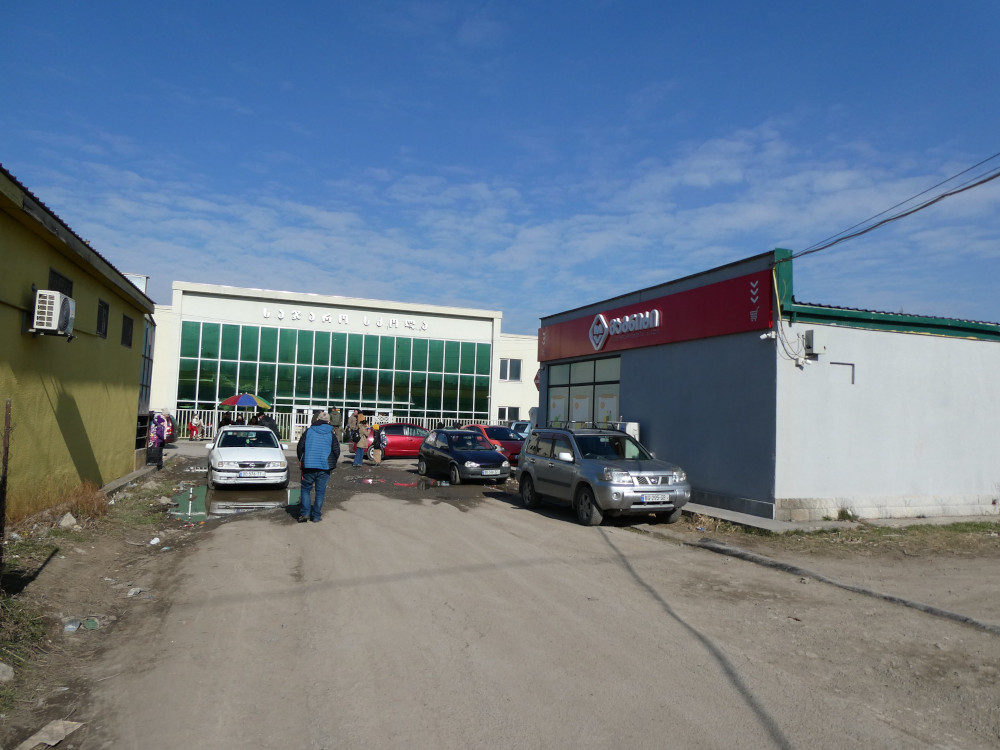
Ikorta is a social enterprise set up by the women of Tserovani. I thought it was overrunning someone’s house but they’ve bought this house specifically to turn it into an enamel studio. A glimpse of the bedrooms shows they’re full of glass and tools and powders and the kitchen remains in place to provide what we assumed was lunch. Enamel is a traditional Georgian craft and you’ll find works of art dating back well over a thousand years using it. But somehow, the art was lost somewhere around the fifteenth century and not rediscovered until the last couple of decades. Now there are plenty of studios in Tbilisi and it’s a popular souvenir all over the country. Here, they’re part of the movement to keep enamel-making alive, they’re employing internally displaced women and they’re raising funds for their people. Now we knew the background on the company and the village, it was time for the class to begin.
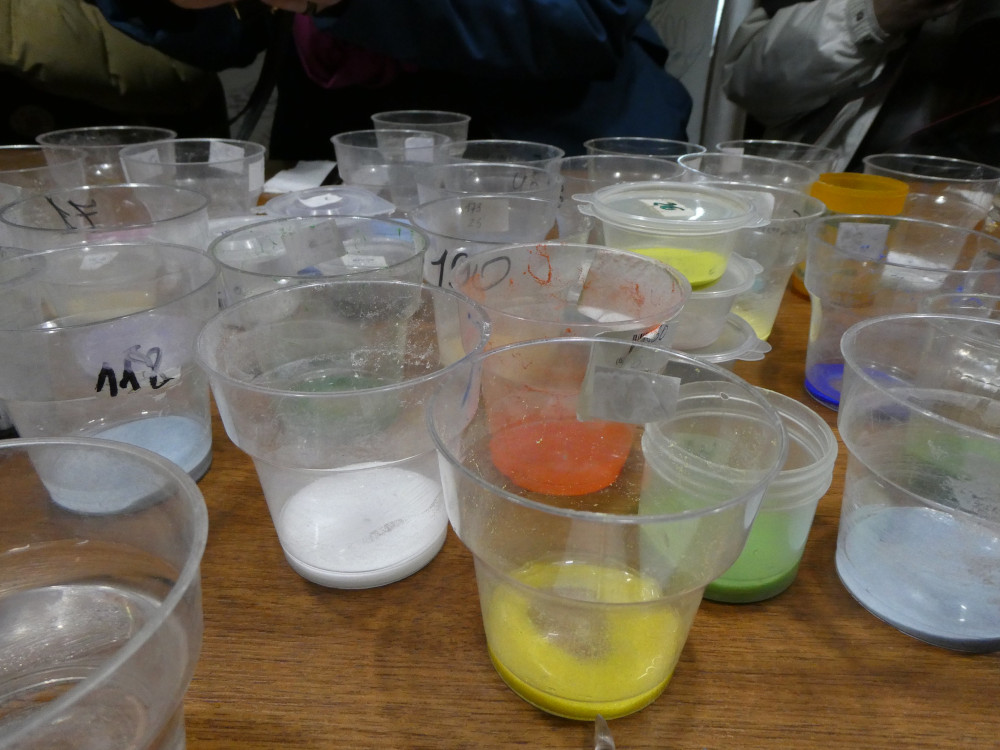
I’d watched a couple of videos on how cloisonné enamel is made and before I even got to Georgia, I’d been wondering how we were going to achieve this complex art in just three hours – or in less than one, as it seemed. Gold, silver or copper wires are meticulously cut and bent to make enclosures, which I think are soldered into place. Then you fill the little spaces with the enamel powder, which is really fine glass powder suspended in water. It’s then fired in a kiln which makes the glass melt and sink down so you have to do several layers to get it full. Last, it’s polished to leave an absolutely flat and shiny surface where you can’t feel the distinction between wire and filling. Ana said this whole process can take four or five days. In order for us to fit it into an hour or so, our pieces were pre-made and we were just going to fill them. In fact, because it would take three layers, or maybe even four, we were only going to do the first layer. Ikorta would fire them, refill in and generally finish them off and hopefully get them delivered to us before we left the country.

It’s a lot harder than it looks. You use your tweezers as a palette – take a scoop of the colour you want on the blunt end and rest them over your water cup. You use a really fine paintbrush to dab the colour into the enclosures. Drop the unused powder back into its colour cup when you’ve finished, wash the tweezers and wash the brush. If you get the wrong colour in any of your compartments, you can scoop it out with the brush and some water or you can ask the Ikorta ladies to do it for you. Other complications: some of the powders, when fired, are not the colours that they appear when they’re in a cup. Ana collected up three white pots, which were actually one white, one orange and one red, so there was a lot of asking “is this one actually white?” and “what colour is this one?” as we went through.

The first difficulty, though, was picking a shape to fill in. There was a lot of choice and we all picked up several before making a decision. Two of the group picked a hot air balloon on account of there being a balloon in the centre of Old Town Tbilisi. One chose a rectangular pendant with little houses on it, to be coloured white with red roofs as a souvenir specifically of Tserovani. One went for a kind of wave/sea shape, and the rest of us went for more abstract floral or geometric patterns. I chose a round pendant with geometric flowers and I decided I wanted some good strong traditional enamel colours – rich blues and greens and reds. Blue was definitely popular.

It all sounds very easy. Just pick some colours and paint within the lines. But it turns out these compartments are tiny and although the paintbrush is very fine, it needs to be a lot finer! I learned that starting with the smallest sectors in yellow was a bad idea – the one colour that’s going to be particularly badly contaminated if you drop a particle of blue or red in it! I did end up scooping out at least two yellow sections and redoing them at the end.

I mentioned “what we assumed was lunch”. Alongside our enamel work, there was a table of Georgian food – khachapuri, pkhali, salad, coffee etc. 1pm passed and Ana said we would go for a short walk around the village to actually get to see it. Half our group was supposed to be doing a cookery class starting at 2pm and we looked at our watches and said “Well, if it’s a short walk and we leave by 1.15, we can be back in time” – at which point our guide said “But we have a lunch”. Yep, an entire separate supra lunch was waiting for us. This here at Ikorta was lunch as far as we were concerned and as far as Ikorta were concerned. I’m planning an entire post about Georgian food and wine later on so I won’t detail the meal in this post. There’s still plenty to come in this one!
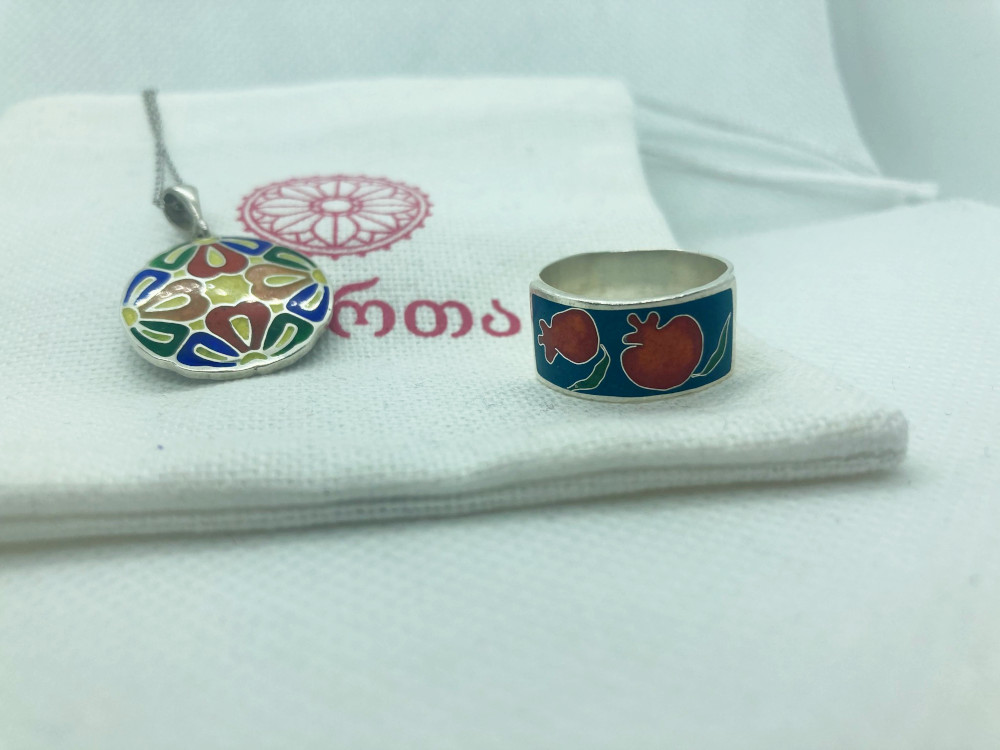
Between our work and lunch, most of us squeezed in time to take a look at the cabinet of pre-made jewellery for sale and dither over all the pieces. I’ve already said enamel is a good souvenir and if we were going to buy any, this seemed the obvious place to do it. I really liked a pendant with a moon over the mountains but I also liked a ring with pomegranates on it and after going backwards and forwards between them, I settled on the ring. Everywhere I’d been in Tbilisi, there had been stalls selling cups of fresh fruit, and piles of oranges and pomegranates which would be freshly squeezed into a cup of juice for you so a ring with fruit on it seemed perfect. The girl who’d done the house pendant bought a little mushroom house pendant for her housemate so that they both had little personalised houses. If you’d like a piece of Georgian enamel of your own and/or to support internally displaced women, Ikorta has an Etsy shop here.

Once everyone was finished, the ten little pieces were put on a wire-mesh bridge-thing and baked in the kiln for a few minutes, then we were all invited to gather around with our cameras to see them fresh out. My first thought was concern. Fresh from the kiln and still boiling hot, the colours were all dark blues and dark oranges but before your eyes, they cooled (not enough to touch!) and the colours came out, the light ones first and then the darker reds last. This wasn’t quite how they’d look when they were finished but they definitely looked different after a first baking to how they looked raw. Now we could see all those whites that were white or red, we could see the difference between the opaque colours and the translucent ones and we could get an idea of how they’d look when they were finished. Plus it was good to see all of them together and get to see what everyone on the other side of the table had made.

Not it was time to go outside. We strolled down the road with the minibus following at less than walking speed. This village is now 15 years old and that’s been plenty of time for it to evolve. With everyone’s modifications, it would be very easy to not notice that all the houses started off identical. Trees and shrubbery are appearing – not at their best in January but when this place was first built, it was bare of all vegetation, which added to the confusion about directions. It’s in quite a narrow valley so it has good mountain views fore and aft and it’s just far enough from the main road that you can’t hear it. I don’t think it’s an ideal place to live by a long way but the locals have certainly made a lot more out of a place that was built quickly and cheaply to be entirely functional. After all this time, many of them might have chosen to move on, to leave the village but it’s clear that most of them haven’t – this is home, this is community, this is friends and neighbours who really know and understand what they’ve been through. And so the temporary shelter has become a home.
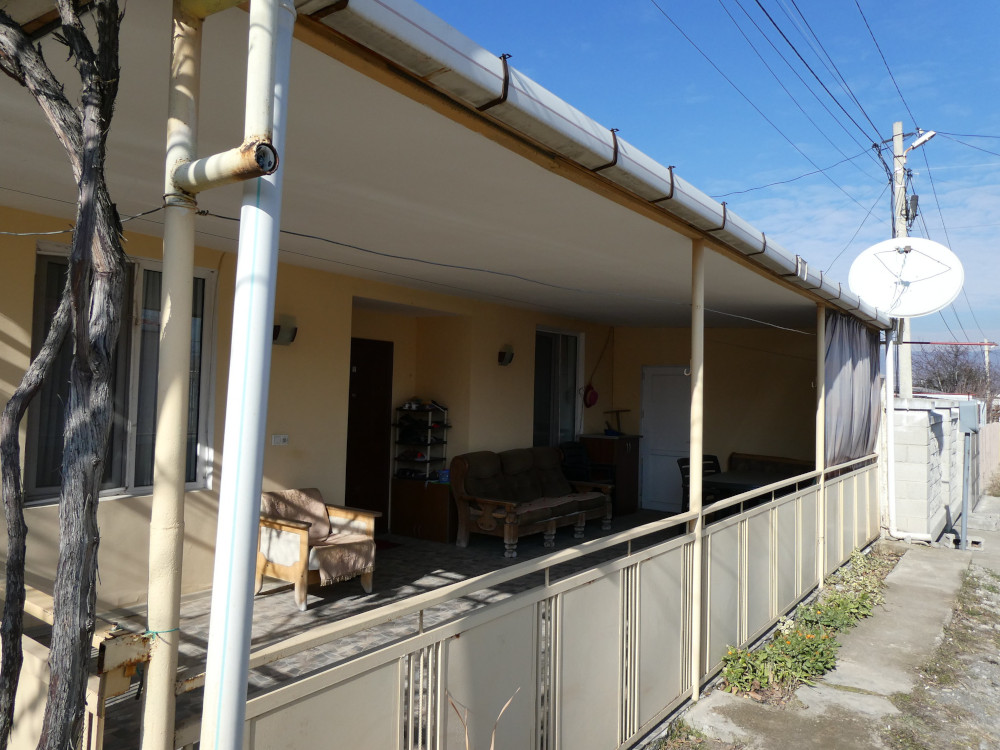
The minibus picked us up from the crossroads with the school and shops. Now we were off for the lunch.
We rattled cross-country away from Tserovani to Mtskheta, Georgia’s ancient capital. While we waited for lunch, we went out to the restaurant’s terrace, which is down by the river and has spectacular mountains right on the other side. The sun wasn’t quite in the right place for good photos but that doesn’t make it any less beautiful in person. The meal took at least a couple of hours – we’d long given up on getting back for the cookery class – and then we went to the church.

Svetitskhoveli Cathedral is “the Georgian Jerusalem”. It’s the Cathedral of the Living Pillar, named after the levitating seventh pillar in the foundations. The pillars were cut from a cedar tree that grew from the grave of Sidonia, who was buried with Christ’s robe – it was brought to Georgia from the crucifixion in the 1st century and Sidonia was so overcome with emotion that she died when she touched it and it couldn’t be prised from her hands, so she was buried with it, underneath what is now the cathedral. It was originally built in the 4th century but over 1500+ years has sustained plenty of damage, either from invasion, from earthquakes or just plain age. The current building is mostly from the early half of the 11th century, so it’s about 70 years younger than Winchester Cathedral. Even so, it’s had plenty of renovations since then. During the most recent round of renovations in the early 1970s, they found the base of the original basilica from the 5th century built by King Vakhtang Gorgasali, who you may remember as the founder of Tbilisi from the sulphur baths post.

In traditional Orthodox style, there are rules for entry, namely that men must uncover their heads and women must cover theirs, plus they must wear a skirt – in this case, the wraparound ones in a basket by the door which you just tie on over your immodest trousers. The tour guide said he didn’t agree with this but it’s easier to not argue with the clergy and just do as you’re told. You’re also not supposed to take photos but he said it’s fine as long as you do it discreetly, without being disruptive or shoving your phone in anyone’s face. He guided us around the cathedral, pointing out lots of interesting things but using his inside-a-cathedral-voice meant it was hard to make out a lot of it. We saw frescoes that were a bit faded and battered – seems they were whitewashed in preparation for a visit from the Russian Tsar in the 1830s although some of them have been partially restored since. And we saw the guide’s favourite king, who I believe was King Erekle II. The guide made him sound like the last king of Georgia but it seems that honour actually went to his son. I’m not entirely sure what made him the favourite but Wikipedia does say he “occupies a special place among the Georgian monarchs, with his name being associated with chivalry and valour” which sounds sort of familiar.

I wish I had more to say about this incredible cathedral. In a fair world, it should have its own blog post, not get tacked onto the end of one about internally displaced people and enamel but I couldn’t catch enough of what our guide was murmuring to get its full story. I got enough to understand that this is a very important and very sacred place and I’m glad we got the chance to go there. I’ve got the important bits – this is the burial place of Christ’s robe and a pillar of life levitated and if you’re in or passing Mtskheta, you should absolutely stop here for a visit.
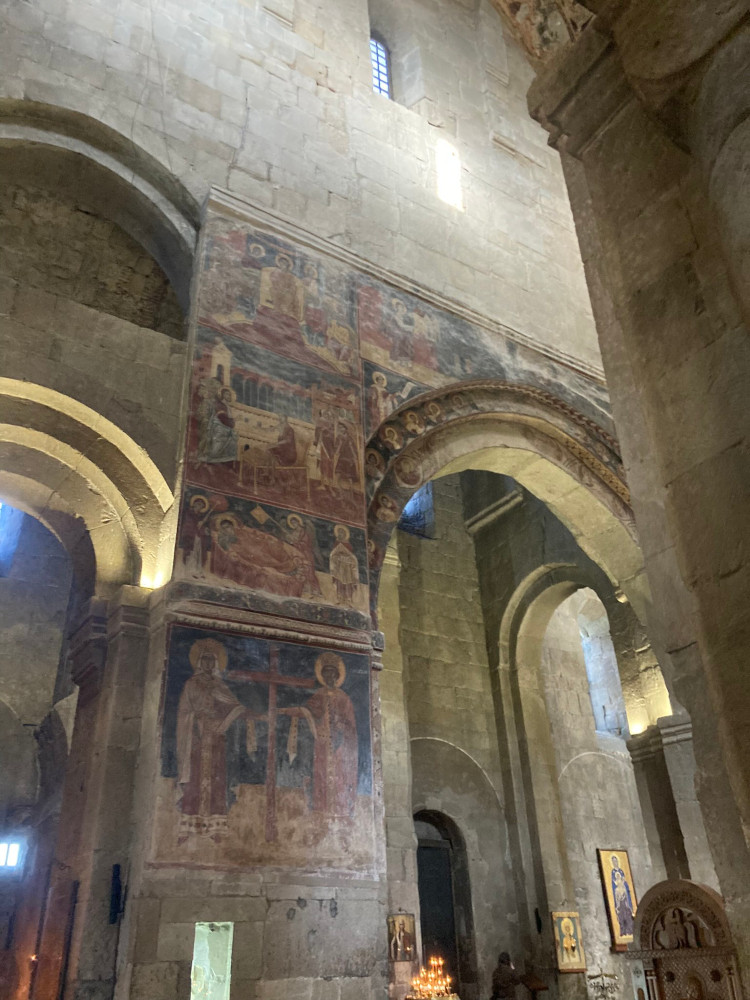
To complete the story of the enamel, we had someone from the Traverse team in our group and she made arrangements with Ana to have the finished pieces delivered to the conference hotel by Sunday and we’d be able to collect them from her at the main desk. In fact, they arrived on Sunday and she delivered them to us personally at lunchtime. I was mostly impressed by the fact that despite no one ever managing to keep track of each other’s names, two of the group came running over with my piece in a little bag with a scrap of paper with my name on it – no “which one is yours? What was your name? Did you make this one?”, just “here’s your finished piece!”. But I was very impressed with the result. It’s so shiny, it’s got a slightly domed finish and it’s so smooth that you just can’t tell it’s wire enclosures filled in with enamel. I’m very aware that I did less than a quarter of the work but still – this is a piece of traditional Georgian art and I made it!
